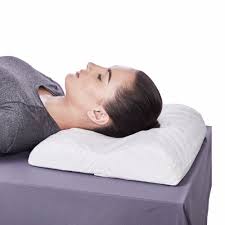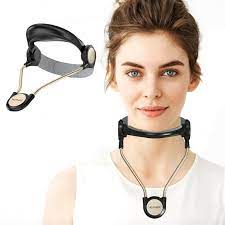

In today’s tech-savvy world, many of us spend hours hunched over laptops, phones, or tablets. One side effect of our screen-heavy lifestyles is forward head posture, also known as “text neck.”
This condition occurs when your head juts forward, putting strain on the muscles of the neck and upper back.
While exercises and ergonomic adjustments can help, there is a growing interest in whether neck support devices might be the key to fixing forward head posture for good.
In this article, I shall explore whether neck posture support can truly reverse forward head posture and relieve the associated discomfort.
I will also discuss various types of support systems, from braces to pillows, and evaluate their effectiveness.
Article Index:
- Understanding Forward Head Posture: Causes and Effects
- Upper Back and Neck Support: The Core of Posture Correction
- Neck Posture Support: What It Does and How It Helps
- Cervical Spine Support Brace: When Is It Necessary?
- Best Pillow for Cervical Neck Pain: Can It Help Correct Posture?
- Neck and Back Straightener: Is It the Solution?
- FAQs on Fixing iPosture via Neck Support
- Conclusion: Is Neck Support the Ultimate Fix?
Understanding Forward Head Posture: Causes and Effects
Forward head posture (FHP) occurs when the head juts forward past its natural alignment with the spine, creating a “text neck” appearance.
This posture places significant strain on the cervical spine and the muscles supporting the neck and upper back.
Over time, the imbalance can lead to chronic pain, muscle stiffness, tension headaches, and difficulty in breathing normally.
A study published in The Journal of Physical Therapy Science found that individuals with FHP experienced a significant decrease in their ability to perform daily activities due to discomfort and neck pain.
The condition is largely caused by poor posture habits, prolonged sitting, and a sedentary lifestyle.
Upper Back and Neck Support: The Core of Posture Correction
When it comes to fixing forward head posture, it’s essential to address both upper back and neck support. The upper back plays a critical role in maintaining proper alignment, as the muscles between the shoulder blades help keep the head in a neutral position.
The idea behind using neck support for posture is to relieve the muscles that have been overworked due to poor alignment.
Support devices help maintain the head and neck in their correct positions, reducing the strain on muscles and allowing the spine to stay aligned. Over time, with proper use, the upper back and neck can regain their natural posture.
Neck Posture Support: What It Does and How It Helps
Neck posture support devices, such as cervical collars or soft braces, are designed to maintain the correct alignment of the head and neck.
These devices work by providing stability, reducing the stress placed on the muscles and ligaments. This support encourages proper posture and helps prevent further damage caused by forward head posture.
Research shows that using neck posture support, especially in combination with posture-correcting exercises, can provide significant improvements in alignment and reduce discomfort.
A 2019 study in Spine Journal concluded that neck braces, when used correctly, helped patients with forward head posture regain better alignment over time, reducing pain and improving their range of motion.
However, it is essential to use these devices as part of a broader posture correction plan, including exercises and ergonomic adjustments.
Relying solely on a neck support device can weaken the muscles over time if not used properly.
Cervical Spine Support Brace: When Is It Necessary?
A cervical spine support brace is often recommended for individuals suffering from more severe cases of forward head posture or neck pain.
These braces can provide more rigid support compared to soft neck collars, keeping the neck in a more static position.
In cases where forward head posture has led to degenerative changes in the cervical spine, a cervical brace may be necessary to prevent further injury.
For example, patients recovering from neck injuries or surgery may require a cervical spine support brace to keep the neck in proper alignment during healing.
According to The Journal of Orthopaedic Science, cervical braces are highly effective in stabilizing the neck during recovery and in preventing long-term damage.
While a cervical brace can be beneficial in acute cases, it is not intended for long-term use. Prolonged use without rehabilitative exercises can lead to muscle atrophy, which could worsen posture in the long run.
Best Pillow for Cervical Neck Pain: Can It Help Correct Posture?
For those dealing with forward head posture and neck pain, using the best pillow for cervical neck pain relief can play a crucial role in maintaining proper neck alignment, especially during sleep.
Poor sleeping positions can exacerbate forward head posture, making it difficult for the cervical spine to recover during rest.
Cervical pillows are designed to support the natural curvature of the neck, ensuring that the head remains in alignment with the spine.
A well-designed pillow can relieve pressure on the neck and shoulders, promoting better posture even while lying down.
A 2020 study published in Ergonomics Journal found that using a cervical pillow significantly reduced neck pain and stiffness in individuals with forward head posture, and contributed to improved alignment over time.
The key is to choose a pillow that supports the natural curve of your neck without elevating your head too much, as this can worsen FHP.
Neck and Back Straightener: Is It the Solution?
A neck and back straightener is another posture-correcting device that targets not only the neck but also the upper back, encouraging proper alignment.
These devices are often worn like a vest or harness and gently pull the shoulders back while supporting the neck.
The advantage of using a neck and back straightener is that it addresses the root cause of forward head posture by improving overall spinal alignment.
This type of device encourages the wearer to maintain better posture throughout the day, reducing the strain on both the neck and upper back.
While a neck and back straightener can be an effective tool in correcting posture, it is important to note that it should be used in conjunction with exercises that strengthen the muscles in the neck and upper back.
Posture-correcting devices, when used correctly, can aid in retraining the muscles to hold the head in a natural, neutral position.
FAQs on Fixing iPosture via Neck Support
Q1: How does forward head posture (FHP) affect overall health?
A1: Forward head posture (FHP) can lead to various health issues, including neck pain, tension headaches, and reduced mobility. It may also affect balance and increase the risk of musculoskeletal disorders.
Q2: What is neck support, and how does it function?
A2: Neck support refers to devices or interventions designed to maintain or restore proper alignment of the neck and head. These supports aim to alleviate strain, correct misalignments, and promote better posture.
Q3: Can neck support devices effectively correct forward head posture?
A3: Neck support devices can aid in correcting FHP by providing external support that encourages proper alignment. However, their effectiveness may vary, and they are often most beneficial when used in conjunction with exercises and ergonomic adjustments.
Q4: Are there specific types of neck support devices recommended for FHP correction?
A4: Various neck support devices, such as cervical collars, posture-correcting braces, and specialized pillows, can assist in FHP correction. The choice of device should be tailored to individual needs and used under professional guidance.
Q5: How long does it take to see improvements in posture with neck support devices?
A5: The time frame for observing improvements varies among individuals. Consistent use of neck support devices, combined with corrective exercises such as neck tilts and ergonomic practices, can lead to noticeable changes over several weeks to months.
Q6: Are neck support devices suitable for everyone with forward head posture?
A6: Neck support devices can be beneficial for many individuals with FHP. However, their suitability depends on the specific causes and severity of the posture issue. It is advisable to consult with a healthcare professional to determine the most appropriate intervention for your situation.
Q7: Can neck support devices prevent the recurrence of forward head posture?
A7: While neck support devices can aid in correcting FHP, preventing recurrence requires a comprehensive approach. This includes regular exercises to strengthen neck muscles, ergonomic adjustments, and mindful posture practices such as lying meditation to maintain proper alignment over time.
Conclusion: Is Neck Support the Ultimate Fix?
So, is neck support the key to fixing forward head posture for good? The answer is both yes and no.
I personally found my best forward head posture fix using a specific exercise routine. It worked wonders for me.
Neck posture support devices, such as cervical braces, pillows, and back straighteners, can play a significant role in relieving neck pain, reducing muscle strain, and promoting better alignment. However, they are not a standalone solution.
To truly correct forward head posture, neck support must be combined with posture-correcting exercises, ergonomic adjustments, and overall lifestyle changes.
Without strengthening the muscles in the neck and upper back, relying solely on support devices could lead to dependency and further weakening of these areas.
As per bestforwardheadposturefix.com, ” Incorporating the best pillow for cervical neck pain, using a cervical spine support brace when necessary, and focusing on upper body alignment can certainly help”.
But long-term results will depend on a comprehensive approach that includes regular exercise, proper ergonomics, and posture awareness.
References:


